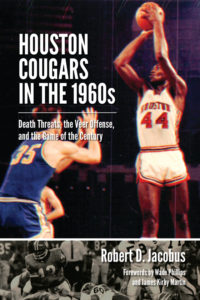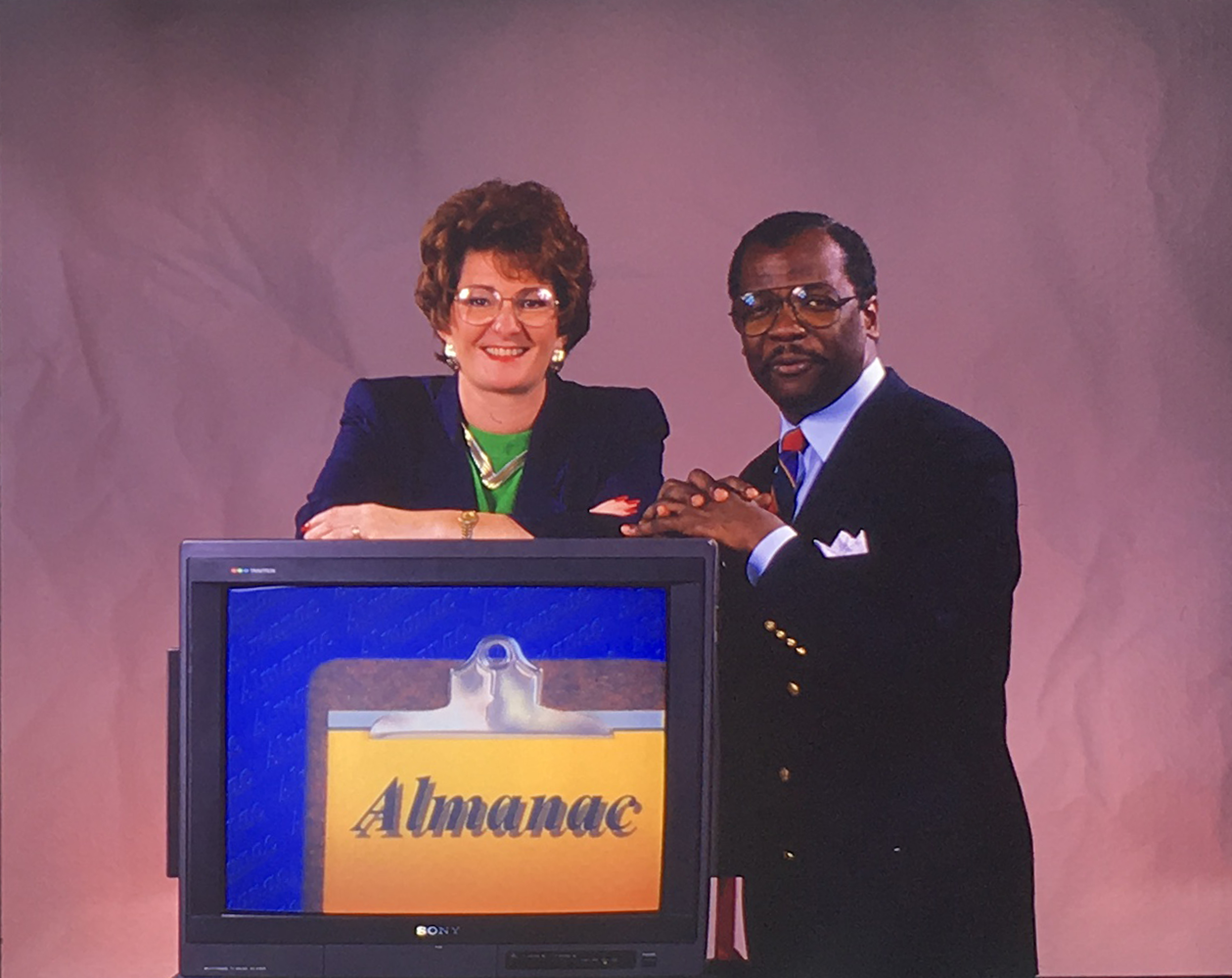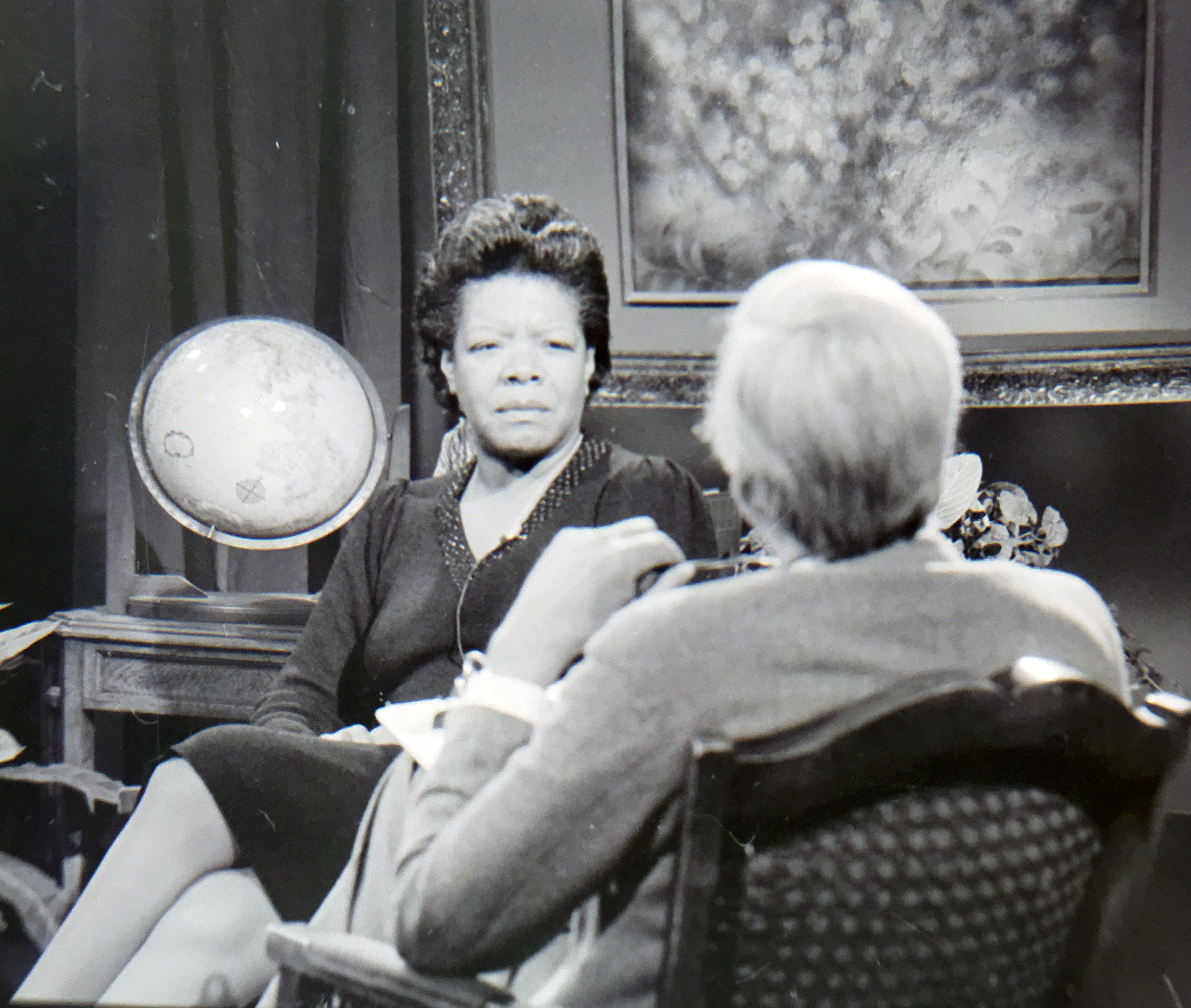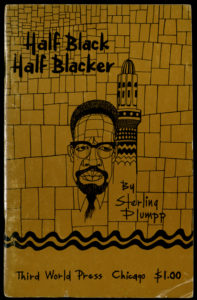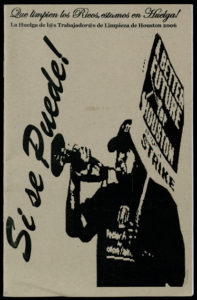
The University of Houston Libraries Special Collections is proud to announce its acquisition of the Ben DeSoto Papers. Ben DeSoto is a Houston native with a photography career spanning over three decades, and his collection documents Houston’s art, history, and culture.
The Ben DeSoto Papers document the Houston art scene and capture the images of hundreds of Houston’s visual artists. DeSoto’s collection also contains photos of hundreds of musicians and performances at many now-defunct Houston venues, including Mary Jane’s, The Axiom, and The Island. The latter venue is the subject of DeSoto’s documentary Night at the Island, which is currently in production. DeSoto describes The Island as
. . . the first venue in Houston where Punk Rock music was heard . . . From 1978 to 1982, the place was a home away from home for many and part of underground scene. Butthole Surfers, Black Flag, Big Boys, The Dicks shared the stage with locals Mydolls, Judys, AK 47, The Hates, and many others.
DeSoto’s collection contains images from these and many other musicians along with photographs of the Houston street skaters Urban Animals, many of which were exhibited at the Glassel and the Houston Center for Photography in the late 1980’s, and the Menil in 1998. Additionally, the collection contains personal and family documents.

Judy Pruitt at 18 years old, under the Pierce Elevated, Christmas week 1988. Photo courtesy of Ben Desoto.
Perhaps most importantly, the Ben DeSoto Papers document DeSoto’s life’s work the Understanding Poverty Project in which he allows us into the daily lives of Houston’s homeless and poor. DeSoto explains that a chance encounter with Judy Pruitt in 1988 led to a decades-long collaboration in “sharing to the public an understanding of underlying causes of chronic homelessness.” Desoto also documented Ben White’s life for over thirty years. Like Pruitt, White battled the cycles of homelessness, drug addiction, and poverty. What is unique to this project is that DeSoto documents the experiences and struggles of Pruitt, White, and their families—over such an extended period of time. Currently, DeSoto is working on Quiet Storms of Reform–what he calls a “poverty solutions documentary film.”
DeSoto received numerous awards during his long career at the Houston Post, including the
- Fuji Fine Arts Award for Contributions to Society (1987)
- National Headliners, Outstanding Feature Photography (1989)
- Inter American Press Association, First in Photography (1990)
- Texas Correction Association Award for Media Excellence for “Documenting the Lives of Children and Families at Risk” (1991)
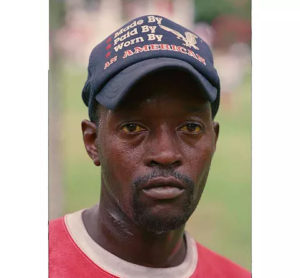
Ben White was born April 27, 1957, and grew up in Houston’s Fourth Ward (Freedman’s Town), Fifth Ward, and Sunny Side, all working-poor black neighborhoods. Photo courtesy of Ben Desoto.
In 2000 Desoto was awarded for his work with the Coalition for the Homeless of Houston/Harris County, Inc.
However, it is the recognition he has received for his more creative work, after his newspaper career, that he most values. A selection of his later awards follows:
- Houston Press, Best Art Exhibit and Best Photographer in Houston award from the for his exhibition His Understanding Poverty at City Hall (2009)
- Houston Arts Alliance grant for The Significance of Making Art
- “100 Creative People in Houston,” Houston Press (2011)
- UNESCO Bioethics Global Arts Competition for his project My Mother’s Dying, which to date has exhibited in Hong Kong, Houston, New York City, Mexico City, and Rome (2013)
- Top Ten Photographers listings: Houston Press, Free Press Houston, Green Mountain Express (2014)
In 2009, the office of Mayor Bill White commissioned City Workers of a Working City, Houston, Texas, which was installed on the third floor of City Hall. The Significance of Making Art was included in the 2009 No Zoning Show at the Contemporary Arts Museum, Houston and at the Artery (2010).
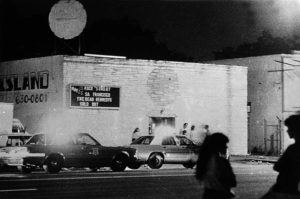
During his internship at the Houston Post the summer of 1980, Desoto particularly enjoyed his assignment taking photographs at The Island, Houston’s first punk rock venue. Photo courtesy of Ben Desoto.
DeSoto’s collection at UH Special Collections totals approximately 44 linear feet, and most materials date from the 1980s through 2016. Five linear feet of the collection came to UH Special Collections organized by Patricia Hernandez of Studio One through the CALL project. Included in this portion are photographs and negatives documenting Houston artists and art events as well as photographs of bands and musicians, primarily at Houston venues. While most of Desoto’s later work has been donated to UH Special Collections, his journalistic work for the Houston Post, as well as a majority of hip hop and materials related to Houston’s Fifth Ward neighborhood, have been donated to the African American Library at the Gregory School.
The collection is currently being processed and a finding aid is not yet available publicly. However, arrangements to use materials in the collection can be made by contacting Performing and Visual Arts curator Mary Manning at mmmanning@uh.edu.
College basketball used to be a small game. A niche sport, once it was played on small courts, in small gymnasiums, in front of small crowds. Just over fifty years ago however, on January 20, 1968 in the Astrodome, the University of Houston (and the University of California, Los Angeles) forever altered the scale of the game in what has become known as the Game of the Century.
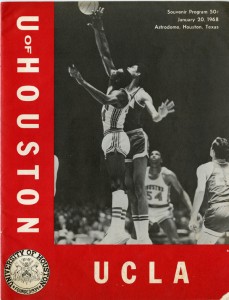
program from the Game of the Century (Athletics Department Records)
Regardless of the particulars, it was destined to be a historic match-up. While any given season might feature similar, high-profile, games between highly ranked teams, the 1968 regular season game between UCLA and Houston had a number of compelling story lines that intrigued even the casual sports fan. There was the blue blood, #1 team in the nation (the UCLA Bruins), riding a 47 game winning streak that spanned two and a half years and boasting three of the last four national championships under the tutelage of the legendary “Wizard of Westwood,” John Wooden. Their most recent in 1967 included a 73-58 defeat of the University of Houston Cougars in the Final Four. Anchored by the immeasurable talent of Lew Alcindor (later known as Kareem Abdul-Jabbar), the UCLA Bruins were a legitimate dynasty, ultimately claiming every national championship between 1967 and 1973. In the other corner, the up-and-coming “underdog” program, ranked #2 in the nation and riding their own winning streak (undefeated since their loss to UCLA the previous season), the University of Houston Cougars were coached by Guy V. Lewis, led on the court by the likes of Elvin Hayes, Ken Spain, and Don Chaney, and eager to prove just how good they were after last year’s setback.
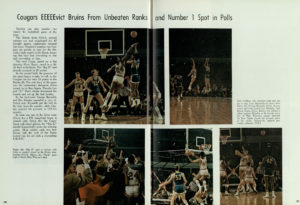
a full-color, two page spread from the 1968 Houstonian yearbook documents the Cougars’ victory
Given all of these particulars, how could the game be any bigger? Mix in a grand stage of national television coverage (a first for college basketball) and the surreal setting of the Eighth Wonder of the World.
The court for the contest was shipped in from Los Angeles, ironically enough, and assembled in the Astrodome on top of what should have been second base. It must have looked like a postage stamp to most of the 52,693 fans (a world-wide attendance record for any basketball game) packed into the dark corners of the Dome. Even more watched at home as this “small” game was played against a grand, cavernous backdrop.
TVS Television Network promoted the game and sold broadcasting rights to over 100 television stations across the country. Previously, there had only been efforts to televise games locally and in 1961 a “national” broadcast of the Ohio State / University of Cincinnati game in the NCAA finals was televised in just two cities–Columbus and Cincinnati, Ohio. The pros in the National Basketball Association had only begun the broadcast experiment in the 1950s and were still torn on whether or not they wanted to televise the league’s “good games,” for fear of losing ticket revenue at the turnstile. What was happening now in 1968 was not just novel, it was radical. And, it was successful in more ways than one. Houston defeated UCLA 71-69, ended the Bruins winning streak, and solidified their place in college basketball lore.
In Houston Cougars in the 1960s: Death Threats, the Veer Offense, and the Game of the Century by Robert Jacobus, Houston’s Elvin Hayes reflected back on the legacy of the game saying, “It just created euphoria and an atmosphere for college basketball that wasn’t there previously. I think that game kicked the door down, opened the windows, and knocked the roof off the house. What we have today in March Madness is what I think the game in 1968 opened.”

The Institute of Museum and Library Services generously funds a “grants to state program,” which uses a population-based formula to distribute funds to State Library Administrative Agencies across the country. In Texas, these funds are distributed via several different types of competitive grants, including TexTreasures, which is designed to help libraries make their special collections more accessible for the people of Texas and beyond.
University of Houston Special Collections is pleased to announce the online publication of over 500 recently digitized videos from the KUHT Collection. These videos, accessible via the newly unveiled UHL AV Repository, were digitized with funds from the Institute of Museum and Library Services’ TexTreasures grant, administered by the Texas State Library and Archives Commission.
Included in the project are several significant series and documentaries produced by KUHT between 1971 – 2000. One series, Almanac, tackled some of the major political and social issues facing Houston in the 1990s, including complex questions of race, gender, and economic inequality. Episodes such as those that cover the Harris County Grand Jury decision not to indict a Houston Police Department officer in the shooting of Byron Gillum and a discussion of the ban on homosexuals serving in the military exemplify the program’s willingness to pursue tough issues. Notable figures, such as Mayor Sylvester Turner, made several appearances on the program early in his political career, and even President Jimmy Carter appears alongside Dominique de Menil to discuss the Carter-Menil Human Rights Prize.

All materials digitized were previously inaccessible due to their obsolete video formats, such as this U-matic video.
Another significant series, The Capitol Report, features interviews with Texas legislators discussing issues that remain of great importance today. Representation, prison reform, and education are just a few of the topics that are covered, and many guests will be familiar to those who follow Texas politics today.
Several noteworthy documentaries and feature programs were also digitized under the TexTreasures grant, such as Houston in the Age of AIDs (1985) and Wetlands (1991).
In addition to full episodes available on the AV Repository, an online exhibit created by graduate student Carolann Madden contextualizes the many series featured online: http://exhibits.lib.uh.edu/exhibits/show/kuht-textreasures, and includes contemporary documents from the KUHT Collection.
University of Houston is excited to announce its procurement of the Zine Fest Houston Records! Consisting primarily of zines (self-published, small circulation, non-commercial booklets or magazines), ephemera, and print items, the collection documents zine culture in Gulf Coast region and throughout the country. Materials in the collection range from the 1980s to present, and focus on a range of topics, including art, feminism, LGBTQ issues, Latina/o’s, and humor.
Curator and archivist for the collection, Lisa Cruces, states, “I’m thrilled to have the ZFH records finally here! Because of their format and the perception of being disposable, zines and other smaller publications are often overlooked, but in my opinion they are valuable snapshots of communities.”
Acquired from zinester, Shane Patrick Boyle, and Zine Fest Houston organizers, Maria-Elisa Heg, Stacy Kirages, and Sarah Welch, the collection is the result of their personal collecting, as well as contributions from the annual Zine Fest Houston event. Usually held in the fall, Zine Fest is a grassroots event dedicated to promoting zines, mini-comics, and other forms of small press, alternative, underground, DIY media, and art. More information on the festival and related events can be found here at the Zine Fest Houston website.
Currently 10 linear feet in size, the Zine Fest Houston Records will continue to grow. “We agreed to donate the Zine Fest Houston Archive to University of Houston because we wanted to share and celebrate the history of the organization and the zines that have been produced by the artists, creators, and activists of South Texas from the early 1990s through today with the entire Houston community, and students, visiting scholars and professors at the University. The University of Houston is also a good fit in terms of location and archive storage facilities. We couldn’t be happier with the partnership that has formed and look forward to adding to the collection throughout the years,” state Heg, Kirages, and Welch.
The Zine Fest Houston Records are currently being processed but open to researchers. For more information, contact Lisa Cruces, ecruces@uh.edu.
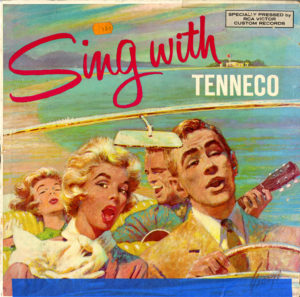
cover of “Sing With Tenneco” vinyl record, undated (Tenneco Energy History Records)
The University of Houston Special Collections is proud to announce the acquisition of the Tenneco Energy History Records as a part of our Energy & Sustainability collections.
In Macon County, Tennessee, shortly after the discovery of natural gas in 1933, Wade Thompson founded Tenneco Gas. In 1943 Henry Gardiner Symonds became the first president of the newly established Tennessee Gas Transmission Company in Houston. The company would be rebranded as Tenneco in 1966, diversifying its business interests and acquiring assets from other industries, targeting failing companies for rehabilitation and profit. Eventually, Tenneco’s holdings included manufacturing, construction, agriculture, shipbuilding, automotive, a chemical company, and, yes, the transmission of natural gas.
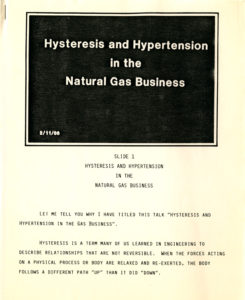
cover of speech, “Hysteresis and Hypertension in the Natural Gas Business,” 1986 (Tenneco Energy History Records)
As the price of oil dropped and the energy economy contracted in the 1980s, financial strains prompted Tenneco to break up the Tenneco Oil Exploration Company and sell off oil and gas assets to multiple suitors including Chevron, Amoco, Mobil, and Conoco in 1988. In the 1990s, Tenneco further reorganized around their automotive and packaging business, selling off their other diffused businesses.
Now, thanks to the generosity of Gary Cheatham, the contributions of Joe B. Foster, and the efforts of many others, the Tenneco Energy History Records are available for research at the University of Houston, in the heart of the nation’s Energy Capital. Foster held a number of positions with Tenneco following his graduation from Texas A&M University in 1957. He was named Chief of Planning and Economic Analysis for Tenneco Oil Exploration and Production in 1968, assumed the role of president of Tenneco Oil in 1978, and retired after 31 years of service to Tenneco as the company altered their strategic direction in 1988. Included in the records are Foster’s notes, speeches, and research over the years, providing some fascinating insight into the energy industry that goes well beyond a simple “boom” or “bust” understanding of decades of tumult in the energy industry. Materials date back to policy documents from the 1970s, exploration reports in the 1980s, and plans related to the reorganization and sell-offs of Tenneco’s various assets in the late 1980s and 1990s.
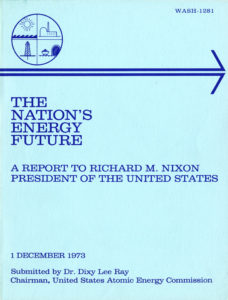
cover of “The Nation’s Energy Future,” 1973 (Tenneco Energy History Records)
The Tenneco Energy History Records serve as a critical piece of our larger Energy & Sustainability collections. Thanks to the assistance of Dr. Joseph Allen Pratt, UH Special Collections has pooled a number of archives, books, and journals that document the history of energy production and its relation to the environment. We encourage researchers to visit our reading room to sample the Tenneco Energy History Records as well as other resources like our Joseph S. Cullinan Papers, the Terry Tarlton Hershey Papers, or the H. David Kaplan Schlumberger Well Services Collection.
